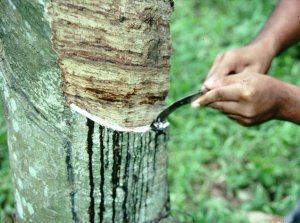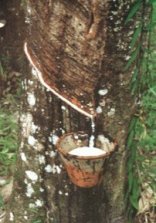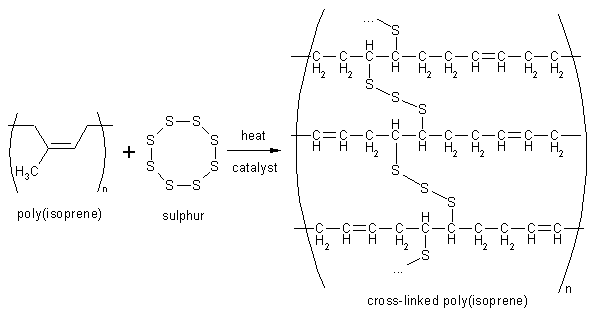(no frames? - click here)
![]()
The tyre manufacturing process begins in the rubber tree plantations of South-East Asia. A sloping cut is made in the bark of the tree, from which a white milk-like fluid called latex bleeds and is collected.
 |
 |
|
Cutting
the sloping incision
|
Collecting
the latex
|
The latex is combined with carbon, oil, sulphur and other chemicals and undergoes a number of processes, many of which are industrial secrets! All this produces black sheets of rubber. The rubber sheets are heated and thin lengths of nylon, polyester or even steel are woven into them to give them rigidity. These woven sheets form the main basis of the tyre.
The inner rim of the tyre is called the "bead ring" and is produced separately to the main tread of the tyre. The bead rings are formed by coating thick wires with the rubber mixture and coiling them up around a template.
The woven sheets and bead rings are joined together and finally the tread pattern of the tyre moulded on top. The tyre produced is not yet complete and is called a "green" tyre. The green tyre is then Vulcanised by applying heat and pressure in special machines to produce the finished F1 tyre.
To see a graphical depiction of the way Bridgestone make their tyres click here.
![]()
One of the key steps in the manufacture is called Vulcanisation, a process invented by Charles Goodyear in 1839. Natural rubber (chemical name polyisoprene) consists of long hydrocarbon chains which are randomly intertwined with one another but have no molecular links between them. By mixing molecular sulphur (a yellow solid) into the natural rubber (which is a sticky, gooey substance) and heating the mixture, sulphur cross-links are formed between the rubber molecules. This hardens the rubber and gives it the qualities of strength and elasticity that one associates with rubber tyres.
 |